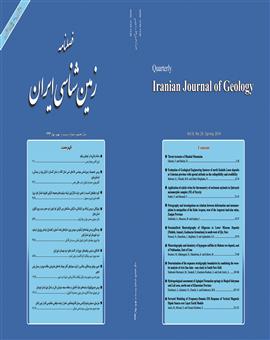بررسی کانی¬سازی و منشأ مس رسوبی چینه¬کران با میزبان کنگلومرای پلیوسن در منطقه قره¬آغاج ماکو
محورهای موضوعی :مهدی مرادی 1 , سجاد مغفوری 2 , محسن مؤید 3 , مهدی عشرتی 4
1 - شهید بهشتی
2 -
3 -
4 -
کلید واژه: مس طبیعی کنگلومرا چینه¬, کران پرکننده فضای خالی ماکو.,
چکیده مقاله :
منطقه مورد مطالعه در شمال غرب ایران و در شمال کمربند افیولیتی خوی واقع شده است. مجموعه سنگ های موجود در منطقه قره آغاج شامل رسوبات سازند قم، توالی قرمز بالایی (URF) و کنگلومرای پلیوسن می باشد. مجموعه واحدهای سنگی پلیوسن شامل سیلتستون، ماسه سنگ (آرکوز، لیت آرنایت) و میکروکنگلومرا و کنگلومرا می باشد. میزبان کانی سازی مس چینه کران در منطقه قره آغاج میکروکنگلومرا و کنگلومرای پلیوسن است ولی در واحد ماسه-سنگی نیز کانی زایی به صورت جزئی دیده می شود. بخش اعظم کانسار سازی به صورت پرکننده فضای خالی می باشد. کانی شناسی کانسار مس قره آغاج بسیار ساده بوده و شامل مس طبیعی، کوپریت و تنوریت می باشد. نبود سولفیدهای مس، عدم وجود فسیل های گیاهی بعنوان عامل احیا کننده، عدم رخداد فرآیند جانشینی مس به جای بافت های گیاهی، وجود کانی زایی بصورت پرکننده فضای خالی و سیمان بین دانه ای و تشکیل کانی زایی به صورت مس طبیعی نشان-دهنده عدم تشابه کانی زایی مس قره آغاج با کانسارهای مس رسوبی تیپ Redbed می باشد. بنابراین سیالات درون حوضه ای طی فرآیندهای دیاژنز از توالی قرمز بالایی نشأت گرفته و باعث شسته شدن مس از توالی مزبور و تشکیل کمپلکس کلریدی مس می شود. افزایش سطح ایستابی باعث ایجاد شرایط احیایی در کنگلومرای پلیوسن شده و سیالات مس دار در طی ورود به این شرایط احیایی، مس خود را در زیر سطح ایستابی به صورت مس طبیعی ته-نشست داده اند. با کاهش سطح ایستابی و افزایش فوگاسیته اکسیژن(Eh بالا)، مس طبیعی تشکیل شده در مرحله قبل توسط کانی های اکسیدی مانند کوپریت و تنوریت جانشین شده است.
The study area is located in the Northwest of Iran and North of Khoy Ophiolite Belt. Rocks of the Ghareh-Aghaj region include Qum formation, Upper Red Formation and Pliocene conglomerate. Pliocene rock units consist of siltstone, sandstone (arkose and lithic arenite) and microconglomerate- conglomerate. Pliocene cicroconglomerate- conglomerate hosted strata bound copper mineralization in the Ghareh Aghaj region, but the mineralization is partially seen in the sandstone unit. Much of the mineralization in the study area is open space filling and disseminated. Ore mineralogy of Ghareh-Aghaj is very simple and contains of native copper, cuprite and tenorite. Lack of copper sulfides, the absence of plant fossils as reducing agent, and the non-occurrence of copper replacement instead of plant tissues, occurance of mineralization as the open space filling and cement grain and formation of native copper as the main ore, all represent the dissimilarity of Ghareh-Aghaj Cu mineralization with Redbed type sedimentary copper deposits. Formation of Ghareh-Aghaj copper deposit can be explained as follows: Pore water formation of diagenetic processes within the Upper Red Formation caused the leaching of copper from this sequence and the formation of copper chloride complexes. Increasing of water table caused the development of reducing conditions in the Pliocene conglomerate. Therefore entrance of Copper-bearing fluids caused native copper deposition below the water table. Decreasing of groundwater table and exposure of native copper to the oxidizing conditions caused the replacement of cuprite, malachite and azurite with native copper.
